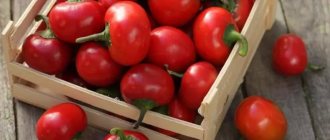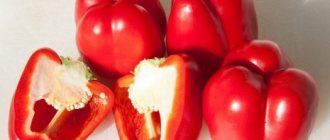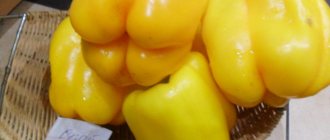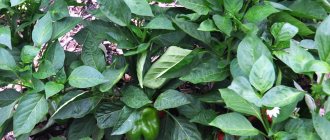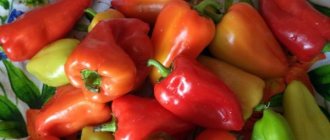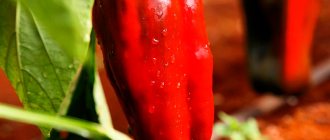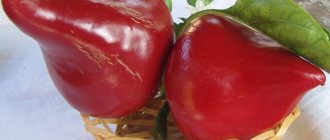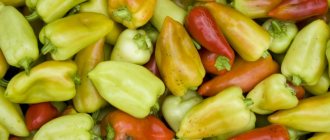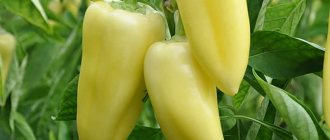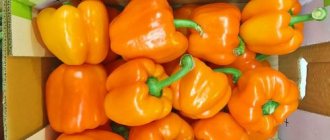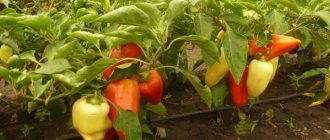Ivanhoe sweet pepper: description and characteristics
According to the description, Ivanhoe is an early variety of pepper ; after the first sprouts appear, 115 days pass and its first juicy red fruits can already be collected.
The thickness of the pulp of this variety can reach about 7 mm, and the weight of 1 pepper is almost 150 g.
This sweet pepper is very popular because it has an excellent presentation and is characterized by high productivity, since more than 70 centners of fruit are harvested from 1 hectare.
According to the characteristics, this variety needs careful care .
If you use very cold water for watering, this can also negatively affect the pepper and it will stop growing.
Ivanhoe has an excellent presentation and is characterized by high productivity
Advantages and disadvantages of the variety
Ivanhoe pepper has a lot of advantages and only one drawback, which is that it does not tolerate bad weather , which is why the greenhouse is a wonderful habitat for it.
As for the advantages , they are practically countless and the most important among them are the following:
- you can get a good harvest very early;
- this variety is not afraid of dense planting;
- it spreads a pleasant aroma;
- has excellent taste;
- stores wonderfully and withstands transportation;
- very resistant to many diseases, especially mosaic and Alternaria;
- Its peculiarity is that it is possible to eat fruits that are not fully ripe and have a yellow color.
The variety does not tolerate bad weather, so it is advisable to grow it in a greenhouse
Advantages and features of the variety
You can get the fruits of Ivanhoe pepper quite early, which is one of the advantages. In addition, they have an excellent presentation, so they are grown for further sale. It is interesting that you can eat yellow and fully matured fruits. From one hectare you can harvest up to 80 centners of crop.
Initially, seedlings are grown from seeds. When it has been growing for 65 days, then it is planted in open ground. With this method you can get the harvest very early. It is not prohibited to plant Ivanhoe pepper densely. The resulting fruits emit a pleasant smell and have an excellent taste.
The main advantage is that the Ivanhoe pepper crop tolerates storage and transportation well. This variety is not afraid of many diseases. But weather conditions can affect the plant. Therefore, it is recommended to grow such peppers in greenhouse conditions, this will allow you to get a lot of high-quality fruits.
Planting seeds
It is very important to choose the right place for growing Ivanhoe pepper. Of course, the place must be fertile, free of weeds and protected from sharp gusts of wind.
To prevent the crop from being subjected to numerous pest attacks, the place where peppers are planted should be changed every year .
This variety loves moisture , so if the area is loamy, it is better to dilute such soil with peat or humus. In addition, sawdust and sand are added to the clay soil.
It will also take care of the seeds. They are placed in a solution of potassium permanganate for 20 minutes, then washed and sown in the soil.
Since pepper does not like transplanting, the seeds should be sown in separate cups . The first shoots should appear within 20 days.
The variety does not like transplanting; seeds should be sown in separate cups
When warm days come outside, the strengthened seedlings are planted in open ground. There must be a distance of 50 cm between the rows, and ¼ cm between the bushes.
The seedlings are planted so that they are at the same level as in the cup. Do this in the evening and be sure to water the holes.
Features of cultivation
Initially, it is worth deciding on the area where the crop will be grown. There should be no weeds on it. The area should be protected from gusts of wind, and the soil should be fertile. Peppers can be planted in the place where the following plants were grown:
- Cabbage
- Legumes and grains
- Onion
- cucumbers
But after nightshade crops you should not plant pepper. It is worth changing the planting location every year. Peppers can be planted in the same area after 3-4 years. This is done to prevent pests from accumulating in the soil. The soil must retain moisture. If it is loamy, then it must be supplemented with peat and manure.
If the selected area has clay soil, then the above components and sawdust, which are not completely rotted, as well as sand, are added to it. A garden with a lot of peat should be combined with humus. It is worth remembering that peppers do not really like transplanting. Taking this into account, initially the seeds for seedlings should be planted in separate cups. In order for it to grow sufficiently, you need to wait 2 months in winter and 1.5 months in summer. Initially, it is necessary to process the seeds.
For this, a solution of potassium permanganate is used, in which the seed material is placed for a third of an hour. After this, it should be washed well and sown in a prepared container. After 20 days, shoots will appear. They need to be thoroughly reconsidered.
Those sprouts that look strong should be moved to separate cups. When the seedlings have already grown up, and the weather is warm outside, you can start planting in open ground. There should be about a quarter of a meter between each plant, and half a meter between each row. It is imperative to remember that hot peppers should not be grown near the Ivanhoe variety. This is because improper pollination may occur.
As a result, the peppers will have a bitter taste. When plants are planted from pots, it is necessary to pay attention to ensure that the stem is immersed in the ground at the same level as it was in the previous container. It is recommended to plant seedlings in the evening. At the same time, do not forget about mulching and watering the holes.
To prevent the pepper from freezing, it is worth covering the bed with film material. The Ivanhoe variety needs careful care. To do this, the plant must be constantly watered, loosened the soil, and fertilized. It is also worth making sure that the soil is not too cold. There are certain rules for watering. The plant is watered at the following times:
- Every time after the harvest has been harvested
- During the landing period
- Every 10 days before the planned fruit harvest
- When 5 days pass after landing
Fertilizing is carried out for the first time when the temperature is around 20 degrees. To do this, you can use a special growth stimulator, for example, Energen. During the growing season, 4 loosenings are carried out. When the soil is loosened a second time, hilling is done. In this method, all weeds are destroyed, and the rhizome is enriched with air.
Watering and fertilizing
In general, when it comes to watering, this needs to be done following a certain pattern. Be sure to water the pepper:
- 5 days after planting in open ground;
- 10 days before harvest;
- immediately after harvest.
Do not forget about fertilizing , which should be carried out during a period when there is a stable air temperature of about 20 degrees.
During this period, you can use growth stimulants. For example, Energen .
If you loosen the soil, the roots of the plant will receive the right amount of air.
How to grow and care for peppers
The first step is to choose a fertile and fertilized area of soil. Peppers like to grow without weeds. Requires constant moisture and does not tolerate dry soil. Loves warmth, constant temperature and sunlight.
Before planting, the seeds are soaked in a weak manganese solution for at least 20 minutes. After which they are planted in cups or other forms. Sprouts from seeds appear on the 20th day. When weather conditions become stable and warm, the crop can be planted in open ground. This should be done at a distance of 50 cm from each other, and the distance between the bushes should reach up to 5 cm.
It is important not to plant bitter peppers next to sweet peppers, otherwise pollination will occur and the vegetable will have a bitter taste. Seedlings should be planted in the evening, preferably on a cloudy day.
You may be interested in: Favorable days for planting pepper for seedlings in 2021: terms and rules for sowing at home Favorable days for picking pepper in 2021 according to the lunar calendar Favorable days for sowing sweet and bitter pepper for seedlings in 2021
Pests
As long as Ivanhoe is growing on your windowsill, you won’t have any problems with it, but as soon as it moves into open ground, you should be prepared to fight pests.
The danger of aphids is that they:
- drinks juices from leaves, inflorescences and stems;
- provokes curling and falling of leaves;
- underdevelopment of fruits.
Favorable conditions for the appearance of aphids are a temperature of about 25 degrees and air humidity of about 80%.
The horror is that these parasites produce about 20 generations per season, so they can easily destroy your crop.
To prevent this from happening, the following means are used in the fight against aphids :
- soap solution;
- tobacco tincture;
- ash.
Aphids on pepper leaves
To prepare a soap solution per 1 liter of water, use 5 tbsp. powder or soap and spray the plant under running water.
Under pressure, the aphids will be washed to the ground and will not climb onto the pepper on their own. Only ants can bring it back.
1 glass of tobacco leaves should be brewed in 5 liters of water and left for 24 hours, then the broth is filtered and the plant is sprayed with it.
What is pepper afraid of, and what conditions are considered unfavorable?
The first problems with growing crops appear during planting in open ground. It is during this period that unfavorable conditions occur, and pests also occur. Despite its resistance to disease, pepper can be attacked by spider mites and aphids, which can cause leaf curling, loss of juice and moisture from the trunk and fruit, and unripening of the pepper.
Aphids can appear when the air temperature reaches 25 degrees. These two parasites spread very quickly and can destroy an entire crop. To combat it, you need to use a soap solution, tobacco tincture and ash. For a soap solution, you need to take 5 tbsp per 1 liter of water. Wash the plant with a spoonful of powder or soap and a stream of water. Aphids and mites are washed away by the pressure of water and can no longer climb onto the plant. Spider mites may appear in mid-June, and if the remedies described above do not help, then you will need to resort to store-bought chemicals.
Unfavorable conditions for the crop are cold weather, lack of phosphorus and copper in the soil, as well as watering with cold water. Therefore, it is better to stand the water before watering. The air temperature in spring and early summer should be maintained at a level and try to plant peppers in fertile or fertilized soil on the sunny side.
Reviews from gardeners
Natalie, 45 years old : “Ivanhoe is one of the most aromatic and delicious varieties of pepper. I freeze it, can it, and add it to various dishes. I have never met a tastier pepper than it. I recommend everyone to plant this particular pepper in their summer cottage.”
Vasily, 52 years old : “I do not accept any chemical treatments and believe that pepper fruits absorb all the harmful substances that then enter our bodies with vegetables, and there are already a lot of all sorts of chemicals in our lives. This same variety is very resistant to various diseases, and for several years now, without any treatments, I have been harvesting simply an excellent, rich and tasty harvest of Ivanhoe pepper. I recommend this variety to everyone, you won’t have any problems with it.”
Lyudmila, 47 years old : “At first my friendship with this variety did not work out, but later I realized that it was my own fault, since I like to water my crops with water directly from the well. And Ivanhoe does not like cold soil and water, so with these actions I slowed down the growth process of the plant. But then, when I read how to properly care for it, everything went like clockwork and I reaped a rich harvest.”
Nikolai, 60 years old : “I have a very small plot and I can’t plant a lot of vegetables, since I need to maintain a certain distance between the bushes. With this variety I can use the soil sparingly, since even when planted densely it bears fruit well. Ivanhoe is an ideal option for a small area.”
Dmitry, 56 years old : “I don’t want to bore anyone with long stories about growing this variety, so I’ll say it briefly and clearly. High yield, ease of care, charming taste. My grade rating is 5+.”
As you can see, many summer residents simply admire Ivanhoe pepper , so if you are thinking about what variety to plant on your plot, then you should definitely take a good look at Ivanhoe.
It will not cause you problems and you will easily reap a rich harvest that will delight you and your loved ones.
Ivanhoe pepper has a pleasant taste and decent yields, which is why it is popular among gardeners.
Characteristics of the variety
Ivanhoe sweet pepper is the result of African selection. It was developed at the end of the twentieth century, and in 1998 it was included in the State Register of the Russian Federation.
Suitable for growing in greenhouse conditions in all regions of the country. It can be grown in open ground only in the southern regions.
From 1 hectare, farmers collect about 80 centners of commercial quality products.
Description of the bush
The bushes are not spreading, have an average foliage characteristic. The height of the bush is 60-70 cm. The leaves are medium-sized, dark green; small wrinkles can be seen on their surface.
Description of the fruit
This variety of sweet vegetable is believed to be an early crop. The fruits begin to ripen within 100 days after the first shoots appear. Biological maturity of fruits is observed after 110 days.
According to the description, the fruits of Ivanhoe pepper have a number of characteristics:
- cone shape;
- smooth surface of the peel;
- average weight - 130 g;
- walls 9 mm thick;
- When technically ripe, the color of the fruit is yellow; when fully ripe, the fruit is red.
The taste is rich and sweet.
Ivanhoe peppers are characterized by a large number of useful microelements in their composition. They contain vitamins C and B, as well as amino acids, which have a positive effect on human health. The fruits are suitable for fresh consumption or for making salads. You can use them to prepare various types of preserves: adjika, pasta, salads, or preserve them in their entirety.
Characteristics of the variety and description of the fruits
The description of the Ivanhoe variety was included in the State Register of Breeding Achievements in 1998. The cultivar was developed much earlier, but appeared on Russian territory relatively recently.
Due to its heat-loving nature, the species is grown in open ground only in the southern regions; in temperate and cold climates, planting is possible only in a greenhouse or greenhouse.
General characteristics and description of Ivanhoe:
- the bush is compact, not spreading;
- shoot foliage is moderate;
- plant height is small, up to 0.7 m;
- dark-colored leaves have medium-sized plates;
- leaf wrinkles are slight;
- the stem is strong and does not require tying;
- shoots do not need pinching.
The average yield of Ivanhoe pepper is 7 kg per square meter, which allows us to consider the variety quite productive.
The fruits are characterized by the following features:
- cone shape;
- smooth glossy surface;
- yellow skin at technical maturity;
- red color after full ripening (see photo);
- wall thickness about 9 mm;
- fleshy juicy pulp;
- weight from 130 to 150 g;
- bright sweet taste;
- Inside there are 2-3 chambers with a small amount of seeds.
The bush begins to bear fruit in early June, continuing to bear ripe vegetables until autumn. The pepper harvest is used in cooking, both for preparing fresh dishes and for canning or freezing.
Planting and growing
Before you start planting, you should select only high-quality planting material. To do this, purchased seeds are placed in water for 2 hours. Those that float are thrown away, and the remaining ones are dipped for 20 minutes in a solution of manganese and a growth stimulator. This disinfects the planting material and accelerates growth. After this, the seeds are taken out and placed on a gauze cloth. In this position they are dried.
The bush has good fruitfulness
Now you can start planting the seeds. It is better to do this at the end of February so that the seedlings are formed by summer. Light, loose soil is taken into the container and filled 2/3 full. Seeds are planted to a depth of 1.5 cm at a distance of 5 cm from each other. After this, the containers are covered with plastic wrap and placed in a dark place at a temperature of 25°C until germination.
Landing
The variety is cultivated mainly under shelters. Seeds are sown from the 2nd-3rd decade of February to mid-March. Initially, they are disinfected in potassium permanganate and soaked in Epin or Zircon to activate germination.
The preferred containers for seedlings are cassettes, pots or glasses. Planting is done in separate containers immediately to avoid picking. The soil is selected that is nutritious and loose. The seeds are buried 2 cm, the containers are covered with film.
At 25-28 degrees, seedlings germinate in 10-12 days.
What further care for seedlings:
- after removing the shelter, the temperature is 18-19 degrees for 10 days, subsequently at 22-25 degrees;
- watering through a spray bottle with warm water;
- additional illumination with phytolamps until the total daylight hours are 12-14 hours;
- fertilizing with complex products or bioinfusions 2-3 times.
The bushes are transplanted into greenhouse beds when they reach a height of 18-20 cm and grow 10-12 leaves. The seedlings are first hardened off on the balcony or loggia.
Diseases and pests
Ivanhoe pepper has a stable immune system, so the Bulgarian fruit variety is not susceptible to such common diseases as late blight, verticillium or tobacco mosaic. Prevention of these diseases is not required.
The main problem for this species can be spider mites, aphids or slugs. You can get rid of these pests using both chemical insecticides and folk remedies. Among chemical substances, preference is given to drugs such as Fitoverm or Atlet-Extra. A solution of these substances is prepared according to the instructions indicated on the package. Folk remedies include tinctures of garlic, onion peels or soap.
A solution of wood ash (1 cup of mixture per 10 liters of water) or tobacco mixture (1 cup of tobacco per 5 liters of water) also helps in the fight against aphids. But against ticks it is advisable to use only chemical insecticides.
Among the new varieties of sweet pepper, Ivanhoe stands out not only for its original name, but also for its excellent characteristics. Reviews from those who planted the variety are positive, and I think that this sweet pepper deserves attention.
Pepper diseases and pests
To obtain a commercial harvest of peppers, it is necessary to create comfortable conditions for the plant and control its condition, since it is susceptible to fungal and viral diseases of nightshades: black leg, white rot, late blight, blossom end rot, fusarium.
In order to avoid the appearance of diseases on pepper plants, it is necessary to carry out preventive measures:
- Disinfect seeds.
- When planting, do not use soil after growing potatoes, tomatoes, peppers or eggplants.
- Use only disinfected soil for growing seedlings.
- Disinfect the greenhouse after the end of the season.
Creating comfortable conditions for plants, killing weeds, using mulch in the beds, and moderate watering will allow you to protect plants from most diseases.
To prevent diseases, spray with fungicides and Bordeaux mixture or copper oxychloride.
The main pests of peppers are aphids, wireworms, slugs, spider mites. Usually in small summer cottages, with constant monitoring of plants, pest control is carried out without the use of chemicals. In case of mass occurrence, use infusions of tobacco, ash, decoctions of dandelion, wormwood, tomato or potato tops.
"Knight" in your greenhouse
This is a semi-standard plant (usually forms one or two stems), a fairly compact plant, which is intended for growing in greenhouses. Ivanhoe is also grown in open ridges, but not always in Russian conditions (regions of the Urals, Siberia, North-West) the summer season is warm, and you can be left without a harvest.
The variety is early, before harvesting fruits of technical maturity you will have to wait about 100-110 days from the moment of germination. The leaves are beautiful, ovoid in shape.
Ivanhoe's fruits are cone-shaped and have thick, fleshy walls. Thickness – about 6-7 mm. The weight of peppers is up to 120-140 grams. There are two or three chambers inside, the seeds are quite large. The pepper pulp is juicy, aromatic, and has high taste qualities.
It is used for stuffing (many people specially grow “cone-shaped” peppers), preparing salads, as well as various preparations. Ivanhoe pepper is disease-resistant, for which it is valued by gardeners from risky farming regions.
Advantages and disadvantages of Ivanhoe sweet pepper
The Ivanhoe variety is among the so-called “top” of the best early sweet peppers, standing out for its high yield and excellent taste of the fruit.
It ripens early, does not require special care, the main thing is to know and follow the basic rules of agricultural technology. "Pros" of the variety:
- early ripening, which is suitable for many summer residents in Russia;
- disease resistance;
- excellent yield;
- tasty, juicy and thick-walled fruits;
- good keeping quality;
- suitability for transportation.
From one square meter, with proper care, you can harvest up to 6-7 kg of excellent sweet peppers. The fruiting period is long, which gardeners also appreciated. The Ivanhoe variety does not require formation, which greatly simplifies care. It is very resistant to diseases common in greenhouse peppers such as mosaic, Alternaria and verticillium.
This variety is widely used for cultivation on an industrial scale.
Among the shortcomings, we note its low resistance to bad weather conditions; nevertheless, Ivanhoe requires a lot of sun and warmth. The best option is to grow in greenhouses (film, polycarbonate), then indeed, the harvests will always please you.
Transplanting
The time for planting peppers in a permanent place is determined by many factors:
- climate of the region;
- weather conditions of a particular season;
- condition of the seedlings.
The soil must warm up to +16-18ºC, otherwise the peppers will be cold. Typically, the Ivanhoe variety is planted in the ground at the end of May or beginning of June (middle zone), when the danger of returning cold weather has passed.
You can add humus and superphosphate to the holes, then plant the peppers, carefully sprinkling the roots with soil.
The distance between the holes for the Ivanhoe pepper variety is up to 30 cm.
Features of growing pepper
To be sure of the quality of the seedlings, it is better to prepare them yourself.
Preparing seedlings
To obtain healthy pepper seedlings, seeds are sown 65-70 days before planting the pepper in the ground or greenhouse.
Before sowing, the seeds must be disinfected in a solution of potassium permanganate, washed, and treated with growth stimulants. Since pepper seeds take quite a long time to germinate, they are germinated in a damp cloth at a temperature of 24-25 degrees. The seeds hatch within a few days.
The soil for sowing seeds is prepared in advance, usually from a mixture of turf or garden soil with compost and ash. If the soil in the garden is heavy, peat or sand is added to it. In this case, you can only use soil from those areas where nightshade plants - potatoes, tomatoes and others - did not grow in previous seasons.
Important! When preparing land for peppers, it is not allowed to use fresh manure.
The soil prepared for sowing pepper is disinfected by freezing or calcining in the oven and moistened.
The hatched seeds are laid out at a distance of 3cm from each other and covered with a small layer of earth (5-6mm), lightly compacted. After this, the box is covered with film or thick paper (but not hermetically sealed) and placed in a warm place.
May be interesting The best varieties of peppers for the Moscow regionSweet pepper “California miracle”: characteristics and description of the varietyPepper leaves curl: reasons, what to do
Important! As soon as the first shoots appear, the box is placed in the most illuminated place in the house; if there is a lack of natural light, artificial lighting is added so that the seedlings do not stretch out.
The temperature during the first two weeks is maintained at 16-18 degrees. Pepper grows very slowly at the beginning of the growing season, and the main task at the first stage is to prevent excess moisture and lack of light. After the hardening stage, the temperature can be increased to 20 - 22 degrees, and the seedlings can be fed with fertilizer.
3-4 weeks after emergence, seedlings are planted in separate containers, peat pots or plastic cups. The seedlings should be well lit all this time, watering should be moderate to avoid blackleg disease.
With the onset of stable warmth, the seedlings are planted in a permanent place - in a garden bed or in a greenhouse.
Pepper care
There are no special techniques in the agricultural technology of the Ivanhoe variety:
- regular watering;
- weeding;
- loosening;
- fertilizing
Water the plants, depending on the weather, at least twice a week. Sweet peppers do not like excess moisture, and they also do not tolerate drought. Therefore, it is advisable to water in a timely manner, only with warm and settled water.
It is necessary to ventilate the greenhouse so that the temperature on hot days does not exceed +30ºC.
Pepper supplements
In order for the harvest of sweet peppers to meet the declared characteristics, it is necessary to take care of “dinners” for the plants.
For fertilizing, it is convenient to use complex fertilizers, where the percentage of all components is known. During the first growing season, when pepper bushes are gaining growth, nitrogen fertilizers are indicated. During the budding phase, more phosphorus is added; at the beginning of fruiting, priority is given to potassium fertilizers.
Excellent results are obtained by dusting the beds with ash, as well as watering plants with infusions of ash. This allows you to provide the pepper with the necessary nutrients, and at the same time protect the crop from diseases and pests.
Pests and diseases
Sweet peppers in a greenhouse can be affected by:
You should not immediately use chemicals; it is better to try to remove the attack using folk remedies:
- infusions of ash, tobacco dust, tansy, garlic;
- dusting the soil between the rows with wood ash or hot pepper.
Many pests, such as aphids, are unusually prolific. Therefore, we must take the fight against this insect very seriously, otherwise the peppers may die. It is difficult to get rid of spider mites, so in the fight against them they use such a formidable “weapon” as Fitoverm.
Dry and bacterial spotting, late blight, verticillium, various types of wilt - all these diseases are easier to prevent than to treat, so compliance with basic agricultural practices is mandatory. Before fruiting begins, peppers can be treated with Bordeaux mixture. You should also follow the rules of planting, avoid excess moisture, and be sure to remove all weeds. If plants are affected by disease, the bushes are carefully removed and burned.
Ivanhoe bushes do not require shaping; pegs for support are installed as needed.
Harvesting sweet peppers
The most pleasant moment for any gardener is the beginning of harvesting. Ivanhoe peppers begin to ripen early (meaning the technical maturity of the fruit), and bear fruit for a long time. Fruits that have reached normal size can be removed and placed for ripening.
It is advisable not to wait for the peppers to fully ripen on the bush, as this reduces the overall yield. They do this only if they receive their own seeds from the fruit.
Harvesting is carried out regularly so as not to inhibit the growth of other fruits on the bushes.
Ivanhoe branches are characterized by increased fragility, so you need to be very careful when harvesting peppers, use pruning shears or a knife.
Reviews
With this variety we always have a harvest. I have a small plot, but I want to grow a lot of things. I plant three varieties of peppers and Ivanhoe is one of my favorites. Very tasty fruits.
This variety was recommended to me by a salesperson in a store. I took it and did not regret it - the fruits are delicious, the bushes are small. I grow peppers in a special greenhouse near the wall of the house. There are no problems with the garter, diseases, and for two years now Ivanhoe has been among my favorites. I use it only fresh, I haven’t used it for seaming.
Nikolay, Leningrad region
I won’t bore you with descriptions of how to care for this variety. The variety is productive, problem-free, the peppers are tasty and what we all especially like is that they have thick walls. I didn’t regret that I bought these seeds three years ago (and I liked the name); now I have my own seeds from ripened fruits. I plant them as seedlings.
